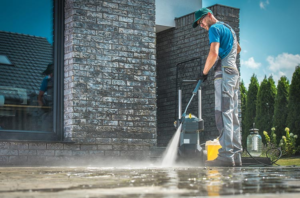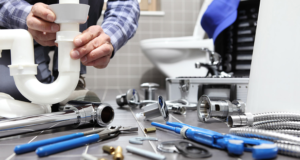Pressure Washing is one of the best and most cost-effective ways to keep your building or facility clean on a regular basis. It is particularly useful for surfaces that are prone to absorbing contaminants such as oil, dirt, salt, and rust.
Power washing is more effective at removing truly stuck materials like mildew, mold, and grease stains, especially when the water is hot. Click Here to learn more.

Decks are constantly exposed to harsh outdoor elements and must be maintained properly to ensure they can remain functional and beautiful. Regular cleaning of the wood surfaces will eliminate dirt, grime and mildew build-up that can lead to mold and other damage. Pressure washing is an effective method for restoring the original beauty of wood decks and it can also help prevent future problems like rot.
Before attempting to pressure wash a deck, it is important to inspect it for any loose boards or protruding nails that the force of the water could damage. In addition, it is recommended that furniture and other objects be moved to allow for unobstructed access.
Once the deck has been inspected, it is time to put on your safety equipment. It is crucial to always wear ear muffs and eye protection when using any type of pressure washer, as the powerful water can cause severe injuries. It is also a good idea to wear gloves when handling the pressure washer.
It is recommended that you start in an inconspicuous area and gradually increase the power of the nozzle as needed to get the best results without damaging the surface. It is also important to maintain a consistent distance between the nozzle and the surface you are cleaning. Too close and you may etch into the surface, too far and you will not achieve a thorough cleaning.
Patios
Patios are a magnet for dirt, dust, pollen and grass clippings. Left unattended, these contaminants cause growth like mildew, moss and lichen that turn the once beautiful outdoor spaces into dirty, dingy areas that are unsightly and difficult to clean. These organisms if not eradicated can also leave behind permanent stains to the brick, pavers and concrete of your patio that cannot be removed.
For the best results, pressure washing your patio should be done in spring or summer during a string of dry days. This allows the sun to help the cleaning process and to dry the surfaces before rain or snowfall occurs. Before attempting to clean your patio, sweep it thoroughly and remove any furniture or items that will be in the path of the washing equipment. We also recommend that you wear rubber boots or working shoes and protective goggles to protect yourself from the spray of the cleaning machine.
We recommend using a walk-behind surface cleaner attachment when washing your patio to ensure consistent pressure and control over the area being cleaned. Avoid using a turbo or fan tip when cleaning, as this can damage the surface of your patio. If you are unsure about how to properly use a power washer, consider having a professional do the cleaning for you. This will save you time and ensure that your patio is cleaned in a safe and effective manner.
Driveways
Over time, driveways can become covered in oil and grease stains as well as dirt and grime. Pressure washing can help to remove these stains and restore the look of your driveway. You may want to pretreat stubborn stains with concrete cleaners or degreasers before pressure washing. These can be purchased in concentrate form and diluted with water for effective cleaning. A scrub brush can also be used to loosen stains before pressure washing.
A high-pressure washer can reach into crevices and hard-to-reach areas to thoroughly clean your concrete surfaces. This can save you time and effort compared to traditional cleaning methods. However, using a pressure washer can be dangerous if you are not familiar with proper safety procedures and how to operate the machine correctly. Therefore, hiring a professional to pressure wash your concrete is typically a safer and more effective option.
Before you begin cleaning, be sure to cover nearby plants and doors with plastic sheets or tarps to protect them from the spray of the water. Additionally, you should remove any outdoor furniture or items from your driveway that could be impacted by the water and debris.
Once you’re ready to begin, adjust the spray wand according to the stain you’re trying to remove. Weak or light stains require less pressure, while thicker stains need more pressure to lift them from the surface. Also, be sure to move the spray wand from side-to-side to thoroughly clean the entire surface area.
Brick
Brick is a common construction material and can be cleaned using pressure washing. The brick must be dry before the cleaning process begins, and the proper chemical cleaner should be used. It’s important to use a wide-angle nozzle for this type of work, so as not to damage the brick with too much water pressure.
Before you start cleaning, it’s a good idea to patch any worn-out mortar joints and let the patching dry for at least a week. This prevents water from seeping behind the brick and encouraging mold to form. Once the patching is done, it’s time to start cleaning. First, saturate the surface to be cleaned with water from your pressure washer’s lowest setting. This will help to loosen any dirt or grime that is stuck on the brick, making it easier to remove.
Next, apply a detergent that is specifically designed for brick. Let it sit for a few minutes to give the cleaner time to break down any stubborn stains, and then rinse it with your pressure washer again. This time, you can use a higher pressure, though you should still stay below 800 PSI, as too much pressure can damage brick. Be sure to keep the nozzle moving as you rinse, and don’t hover over a single spot for too long.
After allowing the brick to dry, it’s time to consider applying a waterproof sealer to your brick surfaces. This will help to protect the brick from future stains, and it’ll make your home look better as well.
Concrete
Concrete is one of the most versatile and widely used building materials. It is very durable when properly constructed and maintained. However, like other types of surfaces, it is susceptible to damage from environmental factors.
Pressure washing is a powerful cleaning method that can be used to revitalize many surfaces including concrete. When washing concrete, it is important to follow proper safety precautions to avoid surface damage and structural damage. It is also necessary to allow new concrete sufficient time to cure before using a pressure washer.
When pressure washing concrete, a gas or electric powered pressure washer rated at 3,000 psi is usually adequate. Choose a system with adjustable settings to control the water spray’s intensity. Select a nozzle with a wide coverage area that delivers a consistent flow and pressure. When washing concrete, be sure to protect hands with gloves and always keep a safe distance from the surface.
For best results, use a detergent designed for concrete pressure washing. Detergents clean concrete much better than regular water and can remove most stains. Always read and follow the manufacturer’s instructions.
A good way to prevent re-staining is to seal the concrete after it has been cleaned. This will prevent dirt and other contaminants from penetrating the concrete’s open pores. This will make the concrete easier to clean next time and help it maintain its integrity.
Masonry
Masonry is a type of construction that involves building walls and structures with masonry units such as brick, stone, or concrete blocks. The units are then bound together with mortar. Masonry is a durable type of construction that can stand up to a variety of weather conditions, including heavy rains and high winds. It is also resistant to insects, making it a good choice for buildings in tropical or arctic climates.
Masonary is also an excellent acoustic material. The thick, dense nature of masonry helps to dampen sound waves, creating an environment that is quieter and more conducive to clear communication and productivity. Its acoustic properties also align with sustainable building practices, as they reduce the need for additional synthetic soundproofing materials.
Moreover, masonry is a natural fire barrier. Its thick walls slow down the spread of a fire, giving occupants enough time to escape safely. In addition, it is an effective way to control the temperature of a building’s interior, as it can absorb and store coolness during the day.
The use of masonry for construction has been around since ancient times, and many famous masonry works still exist today. These include the Great Wall of China, the Colosseum in Rome, and the Pyramids at Giza. It’s important to keep in mind that masonry needs to be properly maintained to prevent structural damage and ensure that it lasts for as long as possible. Pressure washing is an effective cleaning method for masonry surfaces, as it can help to remove dirt and grime that has accumulated over time.



